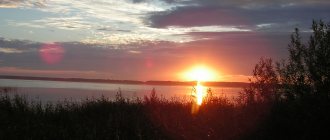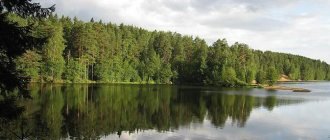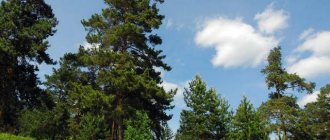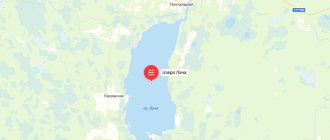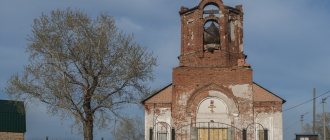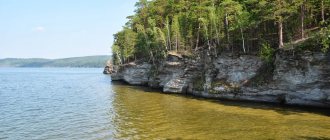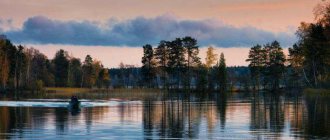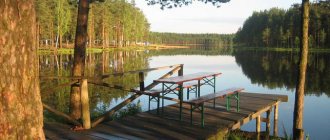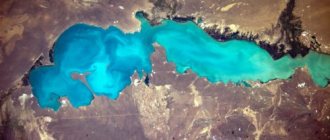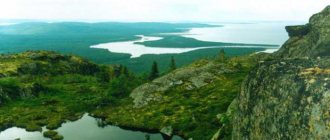Fishing on Lake Kubenskoye
Lake Kubenskoye.
Vologda Region. In the center of the Vologda region, in the Northern Dvina basin, at 110 meters above sea level, the fresh waters of Lake Kubenskoye spread over a huge distance. It is 54 kilometers long and 12 kilometers wide, occupying an area from 370 to 407 km 2
depending on the volume of melted snow. A drop in water level is usually observed in autumn.
The lake has an almost regular ribbon shape. It arose as a result of the melting of the glacier and the flow of melt water into the low-lying area. Lake Kubenskoye cannot boast of great depths. On average they are 1.2 meters, and the maximum values do not exceed 13. The predominant bottom soil is sand, which, together with shallow water and good warming up in the summer months, makes Lake Kubenskoye attractive for a beach holiday. In deep places the bottom is covered with silt.
The lake freezes towards the end of November and opens up by May. Three dozen rivers replenish the lake with water, including the largest ones - Uftyuga and Kubena, and it is carried away by only one - Sukhona. A dam with a shipping lock was built at its mouth. This entire complex structure sinks to the bottom during the flood, since during this period the water in the Sukhona from the Vologda River to the lake flows backwards due to the pressure of the flood waters. Almost as a result of the creation of hydraulic structures, Lake Kubenskoye turned into a reservoir of drinking water for the needs of the residents of Vologda.
The reservoir is navigable, although due to the presence of coastal sandbanks and rocky ridges, the fairway for the passage of ships is quite narrow. The lake has access to the Volga through the North Dvina system and the Sheksna River.
Most of the shores are covered with swamps, where low-growing pine forest grows. The lake itself is covered with sedges, naiads and water lilies, and the shallow water is overgrown with reeds and reeds, in which thousands of wild birds find shelter.
On the shore, along which an asphalt road is laid, stands the village of Kubenskoye, and on the opposite, surrounded by forests and swamps, are the villages of Ust-Kubenskoye and Chirkovo.
The diversity of tributaries and abundant vegetation provide a wealth of fish. On weekends alone, up to two thousand amateurs fish on the lake, whose catch per year is at least 75 tons. Among the main commercial fish are perch, bream, ruffe, pike, roach, pike perch and ide. Somewhat less common in the catch are crucian carp, silver bream, chub, dace and burbot, and with some luck you can catch asp or sterlet. Here you can catch Kubensky nelma, an almost endangered species of fish, and a local landmark - nelmu (a type of whitefish), which is not found anywhere else.
The catch of perch weighs up to half a kilo, but it bites so actively on gear with a 5-gram load that in a few hours you can catch more than a bucket. Pike are caught on average at two kilograms, they bite on a spinner and a long, at least 10 centimeters, weakly burrowing wobbler on three-meter rods in places with large differences in water level.
They catch it and pike perch from a boat using a spinning rod, casting, jig, track, offset and any other tackle that does not cling to the grass. Predatory fish can be caught by trolling. The maximum bite is observed from four to eight in the morning.
From the west in the direction of Vologda, a stone ridge stretches along the bottom, near which perch, pike and burbot are found, but lures often get caught, which makes fishing in these places especially difficult. Pike in this area are better caught on the path if the boat does not move parallel to the ridge, but crosses it in the direction from the shore. A floating wobbler performs well on rocks. The pike produces the maximum number of bites when playing with the bait: twitching, releasing, reaching closer to the surface.
Recently, there is less fish in the lake due to poaching and weak control by the fisheries inspectorate.
Lake Kubenskoye
In the]Vologda region[/anchor], in the Northern Dvina basin, at 110 meters above sea level, the fresh waters of Lake Kubenskoye spread over a huge distance. It is 54 kilometers long and 12 kilometers wide, occupying an area from 370 to 407 km 2
depending on the volume of melted snow. A drop in water level is usually observed in autumn.
The lake has an almost regular ribbon shape. It arose as a result of the melting of the glacier and the flow of melt water into the low-lying area. Lake Kubenskoye cannot boast of great depths. On average they are 1.2 meters, and the maximum values do not exceed 13. The predominant bottom soil is sand, which, together with shallow water and good warming up in the summer months, makes Lake Kubenskoye attractive for a beach holiday. In deep places the bottom is covered with silt.
The lake freezes towards the end of November and opens up by May. Three dozen rivers replenish the lake with water, including the largest ones - Uftyuga and Kubena, and it is carried away by only one - Sukhona. A dam with a shipping lock was built at its mouth. This entire complex structure sinks to the bottom during the flood, since during this period the water in the Sukhona from the Vologda River to the lake flows backwards due to the pressure of the flood waters. Almost as a result of the creation of hydraulic structures, Lake Kubenskoye turned into a reservoir of drinking water for the needs of the residents of Vologda.
The reservoir is navigable, although due to the presence of coastal sandbanks and rocky ridges, the fairway for the passage of ships is quite narrow. The lake has access to the Volga through the North Dvina system and the Sheksna River.
Most of the shores are covered with swamps, where low-growing pine forest grows. The lake itself is covered with sedges, naiads and water lilies, and the shallow water is overgrown with reeds and reeds, in which thousands of wild birds find shelter.
On the shore, along which an asphalt road is laid, stands the village of Kubenskoye, and on the opposite, surrounded by forests and swamps, are the villages of Ust-Kubenskoye and Chirkovo.
There are many equipped parking areas for fishermen and tourists scattered along the shore, but it is better to take firewood with you. The lake has a complex character; winds and storms blow across it, and thunderstorms rumble with unprecedented force above it.
Holidays on Kubensky, in addition to fishing and swimming, can be quite varied both in summer and winter. The recreation centers organize water excursions to the islands, rafting along the channels, and hiking. Rowing boats, speedboats and sports equipment are provided to those who wish. The shallow coastal waters attract parents and children on hot days. In winter, skiing and sleigh rides, ice fishing, snowmobile safaris, cheesecake skiing from the mountains, and a bathhouse with an ice-hole are organized for vacationers.
Lake Kubenskoye has its own unique history. Under Peter the Great, it almost became the site for the construction of the Russian fleet, but its insufficient depth prevented it.
Lovers of antiquity can visit the monasteries and cathedrals scattered along the coast. The most unique of the spiritual monuments is the Holy Stone Monastery, which adorns the tiny island of Kamenny in the northeastern region of the lake. It attracts not only tourists, but also believers who come to pray in the temple, which remembers the famous guardians of Orthodoxy who visited it. The monastery was founded in 1260 by Prince Gleb Vasilkovich of Belozersk in fulfillment of a vow he made during a powerful storm that threatened the death of his ship and crew on Lake Kubenskoye. At that time, the monastery was a stronghold of Orthodoxy among the pagan peoples of the north, as well as a beacon and center of salvation for those in distress during a storm. The monastery was visited by many disasters, it burned down many times, it was restored, closed, blown up, and the stones securing the shore were taken away.
Vologda resident A.N. became the guardian of the island and the initiator of the restoration of the monastery complex. Pligin, who settled on the island with his wife and children. He is also raising funds for the restoration of the monastery.
Rising above the island and the surface of the water, the monastery with a bell tower serves not so much as a place of religious worship, but rather as an adornment of the entire lake landscape. In the vicinity of the monastery you can see ancient stone tables or dolmens, formed as a result of ice lifting stone blocks from the bottom of the lake.
There are several tourist centers along the banks, among which the most popular are: “HillSide”, “Morino Estate”, “Island” and “Kubensky Bereg”.
Holidays on Lake Kubenskoye
Lake Kubenskoye is very picturesque. On a hot summer day, it is pleasant to plunge into its warm water and sunbathe on the sandy shore.
Most of the camp sites are located along the Kubeni River, a short distance from the lake. There is a comfortable asphalt road to the village of Kubenskoye. You can find both unpretentious accommodation options and more comfortable options in hotels. On the shore there are recreation centers “Ostrov”, “Kubensky Bereg”, “Sands”, “Morino Estate” and others. At Exopark Vysokovskoe you can not only stop for a rest, but also visit a mini-farm. The inhabitants of this small zoo are ostriches, ferrets, raccoons, foxes and other animals.
There are campsites for fishermen and tourists on the shores of the lake. Vacationers are also offered rafting and hiking. You can rent a rowing boat or catamaran. In winter, you can arrange a snowmobile trip here.
In places undeveloped for recreation, the shore is overgrown with sedge, reeds, reeds, and water lilies. These dense thickets become home to many birds. The weather on the lake can be very changeable. Winds and strong thunderstorms are common here.
How to get to Kubenskoye Lake
To get to the lake, you need to drive along the A-119 highway to the villages of Kubenskoye, Borisovo or Novlenskoye. Everywhere there are areas for excellent fishing and wonderful recreation. You can also get to the eastern coast of the lake; to do this, you need to follow FT M-8 until the turn to Sokol. There you need to get to the village of Ustye.
This method is suitable for eco-tourists, those who are looking for the greatest distance from civilization.
Lake coordinates for navigators: 5937′51′′N (59.630837) 3927′8′′E (39.452346)
Interesting fact: the reservoir was previously called “Cuban”.
Its size is 54 kilometers long and 12 kilometers wide, due to which it has a peculiar, elongated shape. The depth of the reservoir varies from 50 cm to 10-13 meters.
The lake is located in a lowland, on the borders of the Vologda and Ust-Kubinsky regions. The name “Kubenskoye” comes from the fact that the reservoir flows into the Kubena River. It is fed by about thirty rivers (the main ones are Kubena and Uftyuga), but only the Sukhona emerges from it.
Interesting fact: once every 12 months Sukhona changes its vector and moves in the other direction!
Lake Kubenskoye is also a reservoir from which water is withdrawn for urban needs.
Fishing on Lake Kubenskoye
Fishermen value Lake Kubenskoye not only for the abundance of fish, but also for its beautiful views. Pike, nelma, eel, bream, roach, burbot, and pike perch live here. There are nineteen species of commercial fish in total. Due to the fact that the lake is shallow, fishing on it is only possible from a boat. Local residents willingly rent out their watercraft to vacationers. There is also a very rare fish found in Lake Kubenskoye - Kubensky nelma. Fishing is prohibited in its spawning areas. Lake Kubenskoe has the most perch. The fish always bite well in these places, except during high water. The best time to come for fishing is in late autumn. The lake freezes in the last ten days of November.
In winter, Lake Kubenskoye is also popular among fishermen. Active biting begins a week after ice is established and continues until the end of January. The largest concentrations of fish during this period are in the shallows. In February - March the fish bite little. The bite resumes when the ice begins to thaw. For winter fishing, a winter spinner and jig, as well as a balancer, are useful. White fish bite worse in winter. The lake is free of ice towards the end of April - in May.
A dam with a navigation lock was built at the mouth of the lake. During a flood, the structure sinks to the bottom, preventing flooding of residential communities. Almost Kubenskoye Lake has turned into a fresh water reservoir for local residents. The lake is navigable. However, as has already been said, it is very small. Therefore, the fairway for the passage of ships is narrow.
How to fish on Lake Kubenskoye
The main part of the fishermen are residents of the Vologda and Ust-Kubinsky regions. Many fishermen still use boat fishing. Very often you can meet fishermen on old “Kazankas”, “Progress”, “Veterki”, “Vikryakhs”, which were purchased back in Soviet times, or more precisely in the 60-70s of the last century. These boats are the breadwinners of many local residents. The boats, by the way, are working, although many of their owners have installed modern engines from Japanese and Korean manufacturers.
In recent years, along the ribbon of the lake you can see the construction of recreation centers for fishermen. It is gratifying that residents of Moscow, St. Petersburg and even foreign guests have become interested in fishing on Lake Kubenskoye. In accordance with the decisions of the local Basin Administration, the following rules have been established for fishing on Lake Kubenskoye:
1. Fishing is permitted by all available means; however, no more than 20 hooks are allowed per person.
2. You can use paths and spinning rods to catch the girdle, and the latter requires the presence of a spinner and other artificial baits such as a flyer, a mug, hooks, and a netting net (with a size of no more than 1.5 * 1.0 mm).
3. Fishing with spider nets is allowed, but the maximum diameter of the structure should be no more than 2 meters.
4. It is allowed to use longitudinal bars or bars that have a total number of hooks in the design - no more than 15 pieces.
5. Other devices that do not disturb the natural regime of biological resources of Lake Kubenskoye.
At the same time, the Basin Management established a fishing ban based on the following criteria:
1. In order to preserve the natural balance, fishing for nelma is prohibited at the mouth of the Kubena.
2. It is prohibited to catch all types of fish at the mouth of the Pelma River at a distance of up to 3 km.
3. Fishing at the mouth of the Neig River with a depth of up to 3 km into the lake is completely prohibited.
This ban is based on preventing the extinction of nelma as the only subspecies of fish that is found nowhere else in the world.
Spaso-Kamenny Monastery
In the middle of the lake there is an island on which the Spaso-Kamenny Monastery, one of the oldest in the North, was built. It was founded in 1260 by Prince Gleb Vasilkovich. He did this in gratitude for saving his ship during a powerful storm on the lake. During Soviet times, the monastery was destroyed. Now the Spaso-Kamenny Monastery is being revived. The restoration was initiated by local resident A. Pligin. Today the monastery serves as a real decoration of the lake. The crosses on its domes shine bewitchingly over the majestic surface of the water.
Lake Kubenskoe is also associated with the name of Peter I. It is believed that he wanted to build the Russian fleet here. But the shallow depth of the lake prevented this. The tsar also liked the local nelmushka. Peter ordered to call this fish “royal” and treat it only to the most distinguished guests. If you are lucky enough to catch Kubensky salmon, then make a wish. Locals believe that it will definitely come true.
Tributaries and drainage
About 30 rivers flow into the lake, the main ones being Kubena and Uftyuga. The Sukhona River flows out of the lake, at the source of which a dam with a navigable lock “Znamenity” was built to regulate the flow and water level in the lake. The Znamenity lock dam sinks to the bottom (the base of the dam) for the winter, and remains in this position until the end of the flood on the Sukhona. This technical solution is due to the fact that during a flood (late April - early May), the Sukhona in the area from the mouth of the Vologda River to Lake Kubenskoye flows backward (changes the direction of flow) due to the strong backwater of flood waters below Ustya-Vologda. In fact, Lake Kubenskoye is a reservoir, being the main reservoir of drinking water for the regional center - Vologda.
